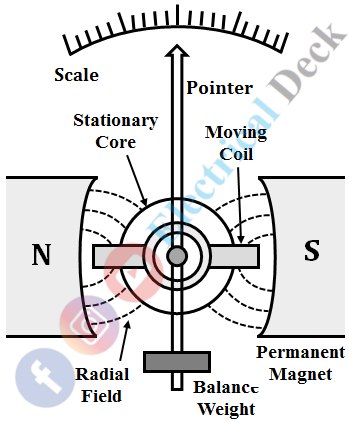PMMC stands for Permanent Magnet Moving Coil. It is the most accurate measuring instrument used for measuring dc quantities. Its working principle is similar to a motor i.e. when a movable coil is placed in the magnetic field it experiences a torque and moves. Here, permanent magnets are used to produce the magnetic field, and hence the instrument called Permanent Magnet Moving Coil instrument.
Construction of PMMC Instrument :
The main components used in PMMC instruments are,- Moving coil
- Magnet system
- Control system
- Damping system
- Pointer and scale
Moving Coil :
Moving coil consists of a number of turns which are made up of silk-covered copper wire. Whenever current flows through the moving coil and is kept in the magnetic field, a deflecting torque is produced and the coil moves due to which the pointer shows deflection.
The coil is wound on a rectangular aluminum former and the length to breadth ratio of the aluminum former is maintained between 1.3 to 1.5 in order to have high torque and high weight efficiency. The former is pivoted on jewel bearings so that the coil sides lie in the air gap between the poles of the permanent magnet. Generally, coils in the voltmeter are wound on metallic frames whereas coils in the ammeter are wound on non-magnetic formers.
Magnet System :
The magnet system consists of permanent magnets. The function of the magnet system is to produce a magnetic field. Permanent magnets are available in different shapes and sizes. The most commonly used is the U-shaped magnet.
In recent PMMC instruments, magnets are made up of materials like Alcomax and Alnico that have a high ability to withstand external magnetic fields without losing their magnetism. Because the magnets are obtained in smaller lengths with high flux densities.
For rectangular magnets, the angular span of scale is 90° only whereas for concentric magnets, it is possible to obtain up to 250° and more. Nowadays, the magnets are designed in such a way that the magnets themselves act as a path for the magnetic field i.e., core.
Control System :
The function of the control system is to produce the necessary and sufficient controlling torque. The control torque in PMMC instrument is provided by two phosphor bronze hairsprings. These springs also allow the current to flow in and out of the coil.
The control torque produced is equal in magnitude but opposite to that of deflection torque, for the pointer to reach the steady-state position. Gravity control and ribbon suspension are also used for producing controlling torque.
Damping System :
The function of the damping system is to provide the damping torque for allowing the pointer to reach the rest position within a short duration of time. The damping produced in the PMMC instrument is electromagnetic damping which is obtained by the movement of the aluminum former in the magnetic field on which the core is mounted. Eddy current damping system and bearing friction also provide the damping torque.
Pointer and Scale :
Whenever the coil moves in the magnetic field, the pointer shows deflection and the deflection of the pointer is directly proportional to the coil current. The pointer is a thin device that is lightweight in construction. It is made up of aluminum and is flattened at one end in order to make it as an edge of a knife.
The pointer is mounted on a spindle that moves a graduated scale and it is balanced by the balancing weight which is connected to it. A mirror is placed below the scale in order to avoid parallax error.
Working Principle of PMMC Instrument :
Generally, the working of PMMC instrument is similar to a motor i.e., how the rotor of the motor experiences a torque in a stator magnetic field. Here the rotor refers to moving coil and the stator field refers to the field produced by permanent magnets. The schematic of PMMC is shown in the following figure.
When the current to be measured is applied to the moving coil terminals placed in the magnetic field. The coil experience a torque and starts moving. This movement of the coil also moves the pointer attached to it i.e., causing deflection of pointer over the scale.
The torque produced is called deflecting torque and it is proportional to flux density and dimensions of the coil. The deflection of the pointer or the deflecting torque produced is in such a way that it is equal to the amount of current flowing through the coil.
Therefore, the value indicated by the pointer over the scale will be equal to the magnitude of the current being measured. It is the most accurate instrument for dc measurements. The accuracy of this instrument is in order of 2-5% of full-scale deflection. Since the deflection of the instrument is directly proportional to the current, the scale can be linear and uniform.
Torque Equation for PMMC Instrument :
Let,- N = Number of turns of the coil
- l = Vertical length of the coil (m)
- d = Horizontal length of the coil (m)
- I = Current flowing through the meter
- β = Flux density between the poles (wb/m3)
- α = Angle made by the conductor with the magnetic field
In galvanometer the field present is radial. Therefore, α = 90°. From Lorentz's force equation, we have, the force exerted on each coil side is,


